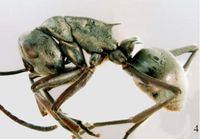Polyrhachis muara
| Polyrhachis muara | |
|---|---|

| |
| Scientific classification | |
| Kingdom: | Animalia |
| Phylum: | Arthropoda |
| Class: | Insecta |
| Order: | Hymenoptera |
| Family: | Formicidae |
| Subfamily: | Formicinae |
| Tribe: | Camponotini |
| Genus: | Polyrhachis |
| Subgenus: | Myrmhopla |
| Species group: | flavoflagellata |
| Species: | P. muara |
| Binomial name | |
| Polyrhachis muara Kohout, 2009 | |
The holotype was collected from Nypa fruticans (Nipah Palm) foliage in mangrove forest along the Brunei River. The paratype was foraging on low vegetation.
Identification
A member of the Polyrhachis flavoflagellata species group.
Keys including this Species
Distribution
Known from from Brunei and Johor on the Malay Peninsula.
Distribution based on Regional Taxon Lists
Indo-Australian Region: Borneo, Brunei Darussalam (type locality), Indonesia, Malaysia.
Distribution based on AntMaps
Distribution based on AntWeb specimens
Check data from AntWeb
Countries Occupied
| Number of countries occupied by this species based on AntWiki Regional Taxon Lists. In general, fewer countries occupied indicates a narrower range, while more countries indicates a more widespread species. |

|
Estimated Abundance
| Relative abundance based on number of AntMaps records per species (this species within the purple bar). Fewer records (to the left) indicates a less abundant/encountered species while more records (to the right) indicates more abundant/encountered species. |

|
Biology
Castes
Known only from the worker caste.
Nomenclature
The following information is derived from Barry Bolton's Online Catalogue of the Ants of the World.
- muara. Polyrhachis muara Kohout, 2009a: 13, figs. 3, 4 (w.) BRUNEI.
Description
WORKER
Dimensions (holotype cited first): TL c. 6.05, 6.40; HL 1.50, 1.59; HW 1.28, 1.31; CI 85, 82; SL 1.75, 1.96; SI 137, 150; PW 0.94, 0.97; MTL 2.06, 2.31 (2 measured).
Mandibles with 5 teeth. Anterior clypeal margin arcuate, only very shallowly incised medially. Clypeus with rather flat median carina, and virtually straight in profile, posteriorly weakly rounding into very shallow basal margin. Frontal triangle weakly impressed. Frontal carinae sinuate, only weakly raised at mid length; central area with distinct, rather flat, median furrow. In full face view, sides of head in front of eyes weakly convex; behind eyes sides immediately rounding into very highly convex vertex. Eyes very large, situated close to posterolateral corners of head, only moderately convex, in full face view clearly breaking lateral cephalic outline. Ocelli absent. Pronotal dorsum convex in profile; humeri armed with distinct, acute teeth; promesonotal suture distinct. Mesonotum in profile flat; metanotal groove poorly marked dorsally. Propodeal dorsum flat, with lateral margins produced posteriorly into more-or-less horizontal, subparallel, medium length, acute spines; propodeal dorsum abruptly rounding into oblique declivity in medially uninterrupted line.Petiole relatively low, armed with a pair of posterolaterally directed, weakly elevated spines and a pair of acute intercalary teeth. Anterior face of first gastral segment widely rounding onto dorsum of gaster.
Head, mesosoma and petiole closely and more-or-less uniformly reticulate-punctate, somewhat more finely reticulate on sides of mesosoma. Gaster finely shagreened. Masticatory borders of mandibles with several curved, golden hairs. Anterior clypeal margin with a single medium-length seta medially and a few short setae laterally. Pilosity absent on mesosoma and sparse on head: only a few paired, relatively short, erect hairs near anterior and basal clypeal margins and along frontal carinae. Several short, erect hairs on front coxae and ventral surfaces of femora. Gaster with several mediumlength hairs along posterior margins of segments dorsally; hairs more abundant on venter of gaster. Medium-length, silvery, appressed pubescence distributed at varying density over most body surfaces; pubescence distinctly shorter on gastral dorsum.
Generally black; mandibular masticatory borders, antennae and legs (including coxae) dark to very dark reddish-brown. Sexuals and immature stages unknown.
Type Material
HOLOTYPE: BRUNEI, Brunei-Muara District, Tanjung Semesta, Brunei River, 5.vii.1994, R.J. Kohout acc. 94.157 (w). PARATYPE: WEST MALAYSIA, Johor, 20 km N of Mersing, 26.ii.1987, B. Fiala #14 (w). Type distribution: Holotype in ITBC; paratype in FIS.
References
- Kohout, R.J. 2009a. A new species of the Polyrhachis (Myrmhopla) flavoflagellata-group from Borneo. Asian Myrmecology. 2(2008):11-16.
- Zettel, H., Ockermuller, E. 2023. Polyrhachis (Myrmhopla) kubani nov.sp. (Hymenoptera, Formicidae) from Laos. Linzer biologische Beiträge 54/2, 679-684 (doi:10.35011@lbb.54.2-48).
References based on Global Ant Biodiversity Informatics
- Kohout R. J. 2008. A new species of the Polyrhachis (Myrmhopla) flavoflagellata-group (Hymenoptera: Formicidae: Formicinae) from Borneo. Asian Myrmecology 2: 11-16.
- Kohout R. J. 2008. A new species of the Polyrhachis (Myrmhopla) flavoflagellata-group (Hymenoptera: Formicidae: Formicinae) from Borneo. Asian Myrmecology 2:11-16.
- Pfeiffer M.; Mezger, D.; Hosoishi, S.; Bakhtiar, E. Y.; Kohout, R. J. 2011. The Formicidae of Borneo (Insecta: Hymenoptera): a preliminary species list. Asian Myrmecology 4:9-58
